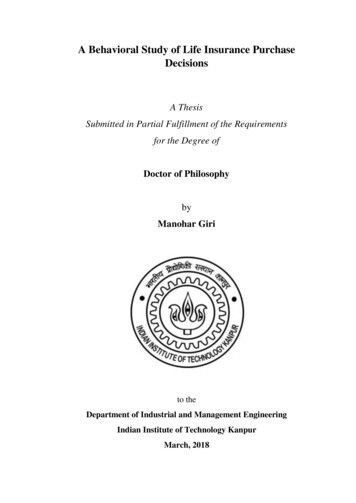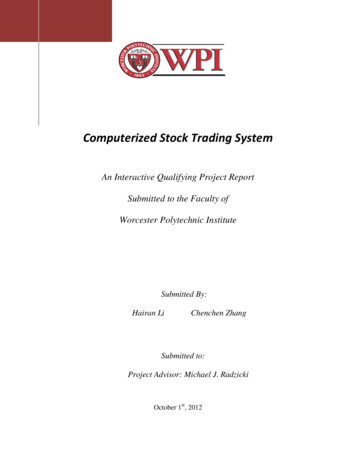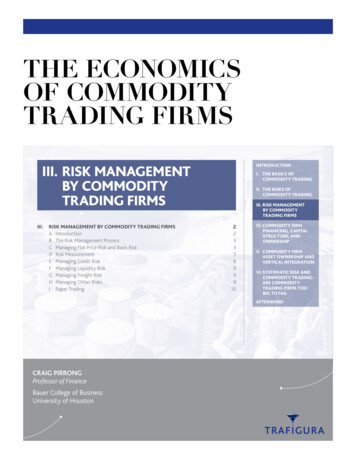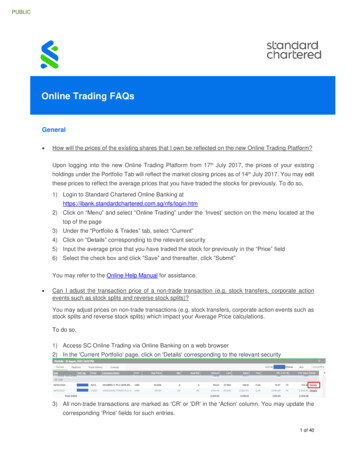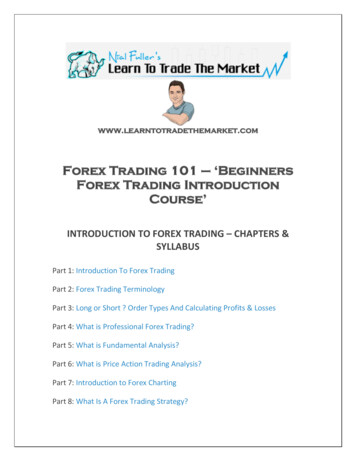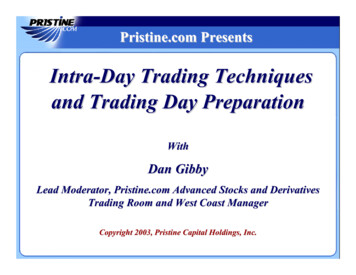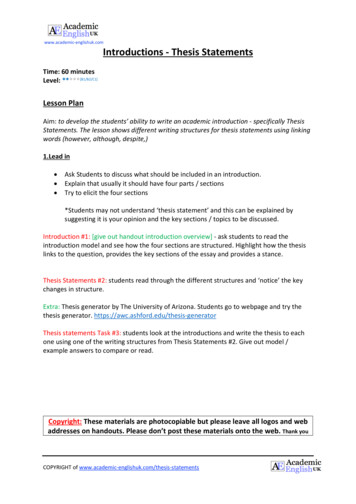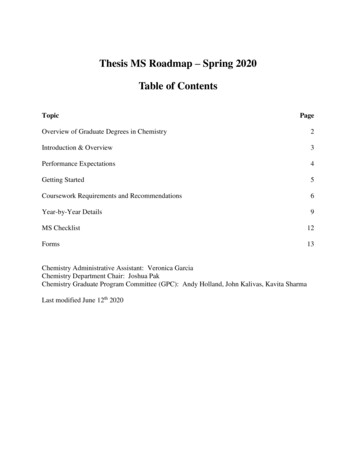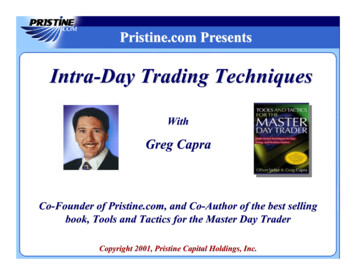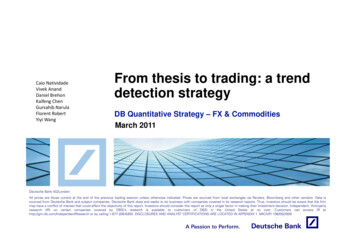
Transcription
Caio NatividadeVivek AnandDaniel BrehonKaifeng ChenGursahib NarulaFlorent RobertYiyi WangFrom thesis to trading: a trenddetection strategyDB Quantitative Strategy – FX & CommoditiesMarch 2011Deutsche Bank AG/LondonAll prices are those current at the end of the previous trading session unless otherwise indicated. Prices are sourced from local exchanges via Reuters, Bloomberg and other vendors. Data issourced from Deutsche Bank and subject companies. Deutsche Bank does and seeks to do business with companies covered in its research reports. Thus, investors should be aware that the firmmay have a conflict of interest that could affect the objectivity of this report. Investors should consider this report as only a single factor in making their investment decision. Independent, third-partyresearch (IR) on certain companies covered by DBSI's research is available to customers of DBSI in the United States at no cost. Customers can access IR athttp://gm.db.com/IndependentResearch or by calling 1-877-208-6300. DISCLOSURES AND ANALYST CERTIFICATIONS ARE LOCATED IN APPENDIX 1. MICA(P) 106/05/2009
Agenda Introduction 1 The theory 4 From thesis to trading model 10 FX valuation and fundamental modelsWh t nextt ? 21What H2 2010 – 1Backtesting,g, validation,, stabilityy and slippagepp gResults 17 Motivation, approach and MSc dissertationImplementation, marketing, internships
Introduction (1) Quantitative strategy is about applying mathematical techniques to understandand predict financial market dynamicsdynamics. Less macroeconomics, more statistics. Understanding the patterns in theinformation. Majorj focus on speedpand dependency,py, not jjust direction. Once we feel comfortable in our understanding, and in the stability of thesepatterns, we employ them in building systematic trading strategies in spot andderivatives accross different asset classes.H2 2010 – 2
Introduction (2) Most of the work is about building and implementing systematic trading models. The clientelle is divided into 2 constituencies: Internal: implement models at given proprietary books, supervised bytrading desks External: educational roadshows with a variety of the bank's clients We run an annual internship programmeprogramme, and the models often result from thework of our interns. When the intern is an MSc or PhD student, we try to link the topic with theintern's thesis. Florent Robert: intern since July 2010. Idea: employ innovative techniques toidentify regime switches in the data. Eventually settled for techniques that canbe implemented in data other than just volatility. The work culminated in a fullyimplementable momentum strategystrategy.H2 2010 – 3
Agenda Introduction 1 The theory 4 From thesis to trading model 10 FX valuation and fundamental modelsWh t nextt ? 21What H2 2010 – 4Backtesting,g, validation,, stabilityy and slippagepp gResults 17 Motivation, approach and MSc dissertationImplementation, marketing, internships
The theory (1)Motivation Markovian regime switchingto model Switches in volatility24%EURUSD Implied Vol22%20%18%16%14% C dit dCreditdefaultsf ltBayesian disorder detectionto model regimegswitches inprices More straightforward, notransition 111.551.51.451.41.35 Fair assumption: FXprices can be modelledlocally as Brownianmotions1.31.251.21.151.1EURUSD Spot01-09H2 2010 – 507-09
The theory (2)Thesis p - Pwhere Detect as quickly as possible a change in the observable system’s behaviour. Timeat which the change occurs: , the change-point. Here change in the system behaviour change in the drift: from 0 to at is the stopping rule, the time of the alarm. We want to minimize the expected miss Introducing, the a posteriori probability process : probability that regime changehas already occurred by time , given the observations available up to that timeH2 2010 – 6
The theory (3)Thesis Approachppusingg Girsanov: from new measure to actual measure H2 2010 – 7New measure: is a Brownian motion independent from Larger filtrationChange using Exponential likelihood ratio processIn the newly defined measureoriginally posited, we have exactly the problem that we
The theory (4)Thesis Bayesy rule: More interested in the dynamics of . Innovations processH2 2010 – 8 Using Levy theorem, - is a Brownian motion in It ’ theorem,Ito’sth
The theory (5)ThesisFinding the optimal stopping rule If you can find such a function Remember thatsuch that, then applying Ito to. Is there a stopping ruleWe can achieve this by taking Showing that exists, we getH2 2010 – 9, you can show thatand then
Agenda Introduction 1 The theory 4 From thesis to trading model 10 FX valuation and fundamental modelsWh t nextt ? 21What H2 2010 – 10Backtesting,g, validation,, stabilityy and slippagepp gResults 17 Motivation, approach and MSc dissertationImplementation, marketing, internships
From thesis to trading model (1)How can it be implemented? The idea is novel: it employs unusual but powerful techniques to detectswitches between 3 market states, a clear improvement from traditional priceaction models (which focus on 2 market states) The clearest application is to a momentum strategy: to be long in an up-trend,short in a down-trend, and neutral in a sideways state In adapting to a trading modelmodel, a few assumptions must be made: Exchange rate price changes can be locally normally distributed The structure of the model does not alter much when evaluated in discretetimeH2 2010 – 11
From thesis to trading model (2)Estimating parameters: a modified validation approach What needs to be optimised? The template distributions: first and second moments according to theslope (gradient) of the trend, and the variability around that slope throughtime. This underpins our assumption of local normality. The switch mechanism: trend length, and thus the way that a trend switchbecomes more likely through timetime. We assume the length of each trendfollows a geometric distribution with an individual parameter. In otherwords, the likelihood of a trend switch rises with time in non-linear fashion.H2 2010 – 12
From thesis to trading model (3)Estimating parameters: a modified validation approachH2 2010 – 13
From thesis to trading model (4)Validation: a sequence of training vs out-of-sample windows Backtest, not simulation Simulation: estimate the future based on today. Popular among pricingmodels. Forward-looking information (option prices) is used in calibratingthe parameters of a process under a pricing measure. These are thenapplied to simulate the likely paths of the process in the future and thus tocalculate the ppresent value of an exotic ppayoff.y Backtest: evaluate the historical performance. The procedure will fit therequired parameters to historical data to identify what best fits the purpose. Simulation uses forward-looking data to estimate value: likely trajectory,then current price. Backtests use past information to estimate value:patterns,ttstabilityt bilit andd ththen ttradingdi ddecisions.i iBBacktestskt t evaluatel t goodnessdof fit, a key component of trading strategies based on statisticalconvergence.In most of our models, we calibrate parameters based onbacktests.H2 2010 – 14
From thesis to trading model (5)Validation: a sequence of training vs out-of-sample windows Overfitting: dangers of backtesting In-sample vs out-of-sample treatment Modified K-fold cross-validation: cut the datainto smaller in-sample and out-of-samplewindows, and use data to train and test. Optimise parameters in-sample according torisk-adjusted performance.Out-of-sample Sharpe ratios4Out-of-sample in-sample3Out-ofsample 1/2 * insample2 Evaluate performance outout-of-sample;of sample; in agood model, the in-sample performance isgenerally a good predictor of out-of-samplereturns.H2 2010 – 1510-1-2-0.500.511.522.533.5In-sample Sharpe ratios
From thesis to trading model (6)Stability and operational risks K-fold window choice: robustness vsadaptability Stability: what happens to your equity curveif you bump the data? Operational reality: what happens to yourequity curve if you bump transaction costsand execution time?H2 2010 – 16
Agenda Introduction 1 The theory 4 From thesis to trading model 10 FX valuation and fundamental modelsWh t nextt ? 20What H2 2010 – 17Backtesting,g, validation,, stabilityy and slippagepp gResults 17 Motivation, approach and MSc dissertationImplementation, marketing, internships
Results (1)Positive aspects The results for EUR/USD are positive and linear. Intra-hour frequencies are noisier, and produceless trends; lower frequencies do better. IIndividualdi id l returnstare somewhath t similari il ttotraditional momentum: low hit ratios ( 50%) buthigh positive-to-negative trade returns ratio. More linearly consistent returns compared to astandard technical analysis strategy. Combining individual frequencies gives betterreturns. The model addresses shorter and longertrends. Positive and asymmetric correlation to EUR/USDimplied volatility.H2 2010 – 18
Results (2)Positive aspectsH2 2010 – 19
Results (3)Risks and future work Are we capturing enoughinformation by fitting a state into 2parameters? The model assumes trades can beexecuted at any time of the day. Isthat realistic? What are theimplications of execution delay? Does it really perform better than asimpler MACD strategy? Is this the best way to implement apricei actionti switchit h model?d l?H2 2010 – 20
Agenda Introduction 1 The theory 4 From thesis to trading model 10 FX valuation and fundamental modelsWh t nextt ? 21What H2 2010 – 21Backtesting,g, validation,, stabilityy and slippagepp gResults 17 Motivation, approach and MSc dissertationImplementation, marketing, internships
What next? Internalimplementation Follow-upresearch notes Educationalroadshows What model willcome next?H2 2010 – 22
Internships in FX & Commodity QuantStrategy Opportunity to join a team ranked as: #1 in FX Quantitative Strategy by the Euromoney Survey (2009, 2010) #1 in Derivatives Research byy the Risk Awards Surveyy (2011)() Top 3 Commodities Research team by Energy Risk (2011)Opportunity to join a bank ranked as: #1 in Foreign Exchange by the Euromoney Survey (past 6 years) #1 in Commodity Derivatives by IFR (2011) Looking to hire 1-2 interns Preference for 1-year internships, but flexible duration and flexible start date L ki ffor candidatesLookingdidwithi h strong quantitativei i andd computingi skillskill caio.natividade@db.comH2 2010 – 23
H2 2010 – 24
From thesis to trading model (4)From thesis to trading model (4) Validation: a sequence of training vs out-of-sample windows Backtest, not simulation Simulation: estimate the future based on today. Popular among pricing models. Forward-looking information (option prices) is used in calibrating the parameters of a process under a pricing measure.
